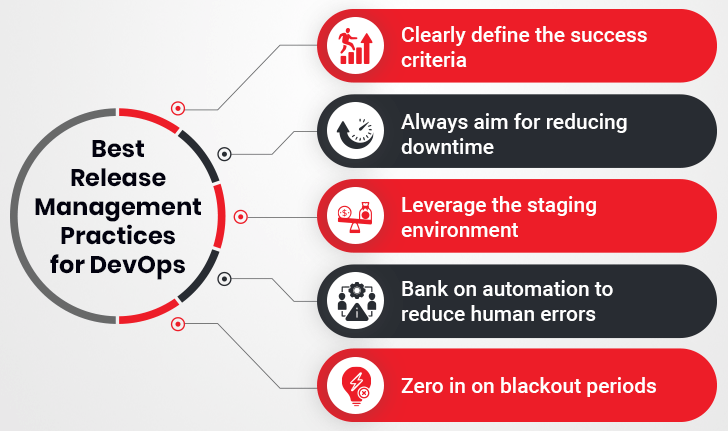Gone are the days when SDLC and release management used to be nerve-wracking tasks for software developers. However, with the incessant surge in DevOps release management practices and tools, businesses have started capitalizing on the new techniques that revolve around augmenting the efficiency of software developers. Thanks to a slew of DevOps tools and best practices that bring unmatched speed, reliability, improved visibility, and collaboration to a release management process and make it stress-free. Before we unveil the best release management practices, it’s important to understand what exactly release management is. Let’s dive into it.
What is Release Management?
Release management in the realm of IT operations and software development is an end-to-end process that oversees the several stages involved in planning, scheduling, and managing software builds or releases from product development and QA to deployment across all environments. DevOps encourages improved visibility and collaboration across the software development lifecycle, which in turn, reduces feedback loops and accelerates release management.
Although release management is relatively a new term for many software enterprises, it has had a significant role in the SDLC before it was renowned as release management. Until a few years ago, deciding when and how to release software builds was a big problem for developers. Today, many software enterprises have shifted from rigid release dates to SaaS business models, wherein, release management is a continuous process that works alongside software development.
Best release management practices for DevOps

1. Clearly define the success criteria
When it comes to defining the criteria for a successful software release, you can’t be subjective, else, it will directly impede the growth required to determine what works best for your business and your development team. Having coherent acceptance criteria (AC) for quality analysis (QA) will lead to fast and stable releases. Therefore, it is strongly recommended that product owners, testing managers, and release managers should collaborate to conform to the acceptance criteria (AC) and the critical release metrics before taking a step ahead with a new project.
2. Always aim for reducing downtime
It is always seen that seasoned product release managers work incessantly to reduce customer impact and high downtime. Real-time collaborative alerting, active monitoring, and proactive testing can help you discover potential issues during the software release.
3. Leverage the staging environment
A staging environment is an imitation of a pre-production environment, wherein, developers can closely monitor, test software or applications, and make required changes before going to the production environment. For successful release, every stakeholder from product owners to testing professionals should run the test and comb through the staging environment to discover potential issues.
The important thing to note here is that as long as your pre-production environment is a replica of production, you can easily discover potential issues or bugs in the staging environment itself before deploying the changes to the live application. A collaborative pre-production environment not only reduces customer impact but also enables DevOps professionals to make sure that software releases meet acceptance criteria (AC) without any delay.
4. Bank on automation to reduce human errors
The key to success in DevOps release management is automation. You should always automate anything that can accelerate the efficiency of your workforce, technology, and operations. When it comes to software or application development, testing, or other IT operations, automation can help you cut down human errors, streamline the process, and make daily operations easier than ever. The best way to manage product release in DevOps software development is to let your seasoned workforce invest their productive time in strategic thinking rather than performing repetitive, mundane, and menial tasks. This way, you can deliver best-in-class services to your customers both existing and new ones.
5. Zero in on blackout periods
A blackout period is a predefined period of time during which businesses don’t deploy new features or functionalities into the production environment unless it is critical. Generally, the blackout period begins from Halloween and ends after Christmas and New Year for many North American companies. In other words, black periods occur during the holiday sales season. Some businesses also prefer to have their blackout periods around the financial year.
Wrapping up
DevOps implementation, a cloud-based solution that not only establishes a smooth release management structure but also offers modern practices for improving collaboration and QA across the software development lifecycle. While businesses are more inclined towards automation to drive success in DevOps, automation should influence the efficiency of developers. As automation cuts down human errors and improves operational efficiency, DevOps service providers will start offering release management services quickly.
If you also want to release products at a faster rate and DevOps perfectly suits your business needs, Damco Solutions is the right tech partner you should associate with. Our DevOps team is equipped with best-in-class monitoring and alerting tools to tackle the challenges that come in their path of success.




